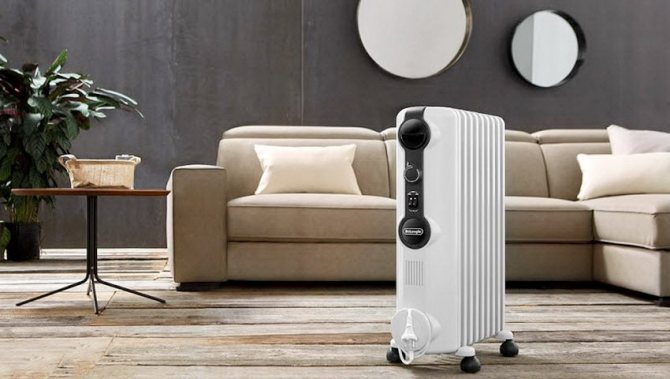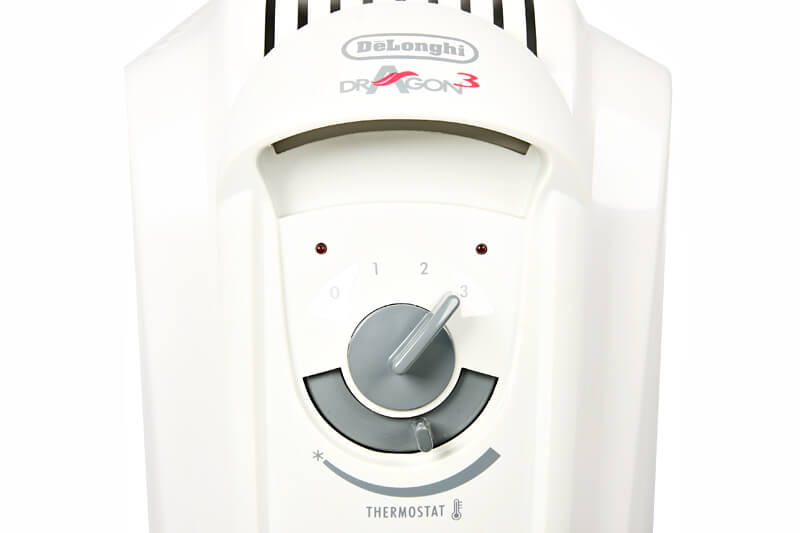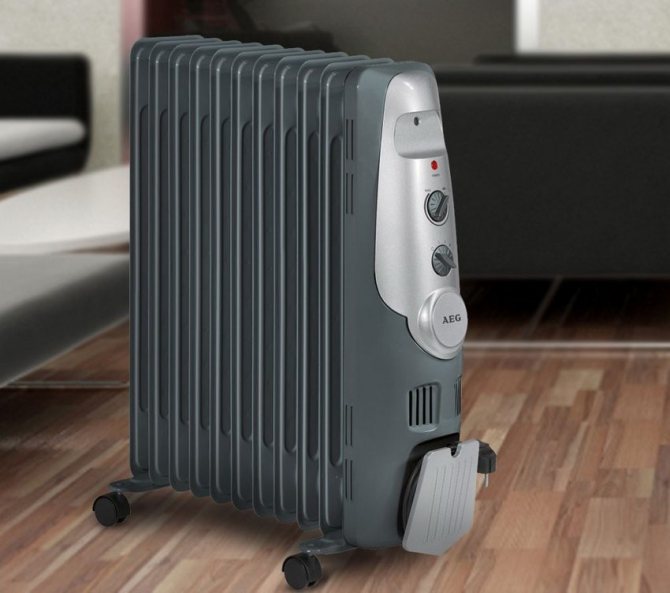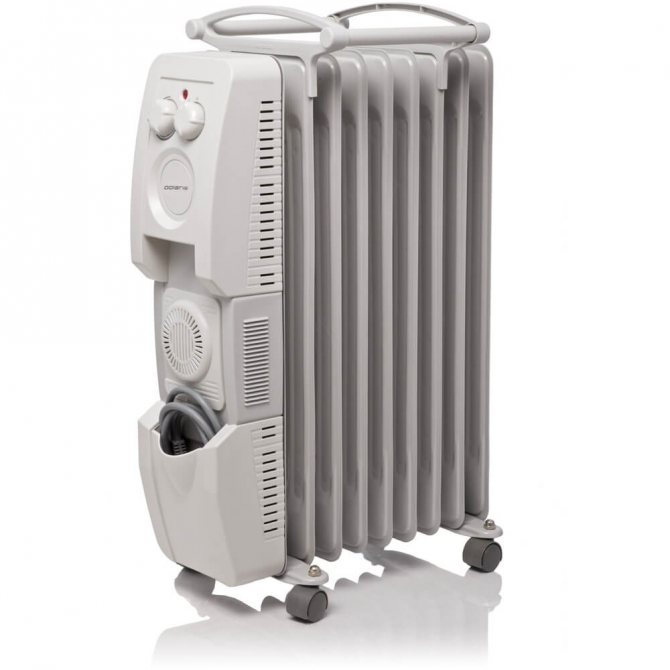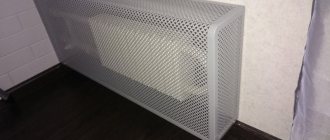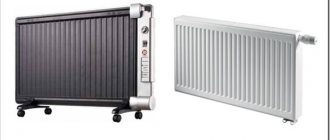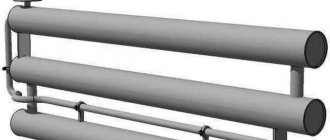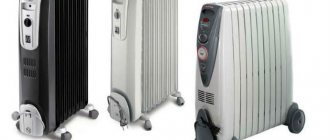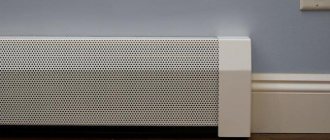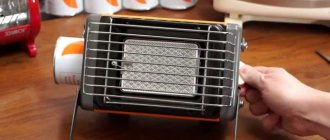SHARE ON SOCIAL MEDIA
FacebookTwitterOkGoogle + PinterestVk
Central heating is not always sufficient to provide a comfortable home environment. Therefore, it is often necessary to use additional heating devices. The most popular of them are a convector or an oil heater: which is better, you can decide by familiarizing yourself with the advantages and disadvantages of these devices, as well as the features of their use.
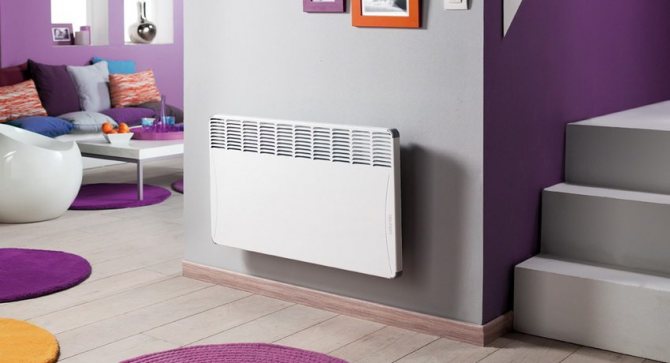
Heaters can be both primary and secondary heat sources
The principle of operation, pros and cons of an oil heater
When choosing an oil heater for your home, you should understand how it works. Outwardly, it is a metal case, inside of which there is a container with mineral oil. After turning on the device, the heating element starts to work, which increases the oil temperature. The oil, in turn, heats up the metal body, and it gives off its heat to the environment. This takes quite a long amount of time, but the heat spreads evenly throughout the room.
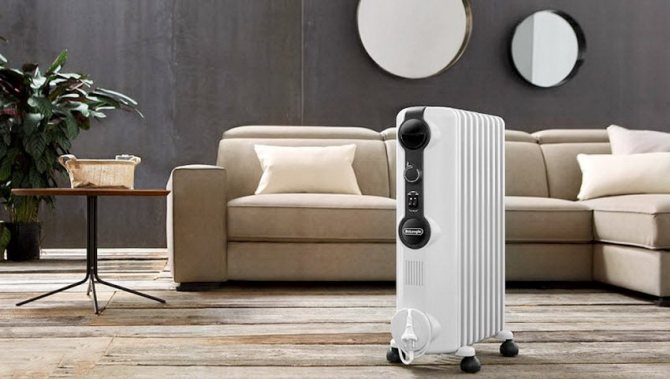

Oil heater heats the room slowly but evenly
The intensity of air heating in such radiators, as a rule, is regulated, and the design is equipped with wheels for greater mobility. There are floor and wall oil heaters. It is advisable to buy the latter if there is a small child or pets in the house. This heater works for periods. When the room temperature rises to the desired level, the built-in sensor turns off the heating element. When the temperature drops, the opposite process takes place. Thus, the use of an electric oil heating radiator saves energy.
Of the advantages of an oil cooler, the following can be distinguished:
- High level of safety - all heating elements are hidden inside the case, so you can not be afraid of getting burned on the oil heater. In addition, most models are equipped with a special sensor that turns off the device in the event of a rollover.
- No noise during operation - you can safely install a household electric oil heater in your bedroom or office. Also, the device takes up little space, and it can be placed not only on the floor, but also on the wall.
- Long service life - the heating element of the oil cooler is reliable and durable, and the device itself can work for several days without interruption. Most modern models are equipped with built-in overheating protection.
- No unpleasant odor is emitted during operation. In addition, modern oil heaters (Delongy and other firms) do not dry out the air in the room, so you do not have to buy an air humidifier complete with the device.
- The price of the heater is quite low, so everyone can afford it.
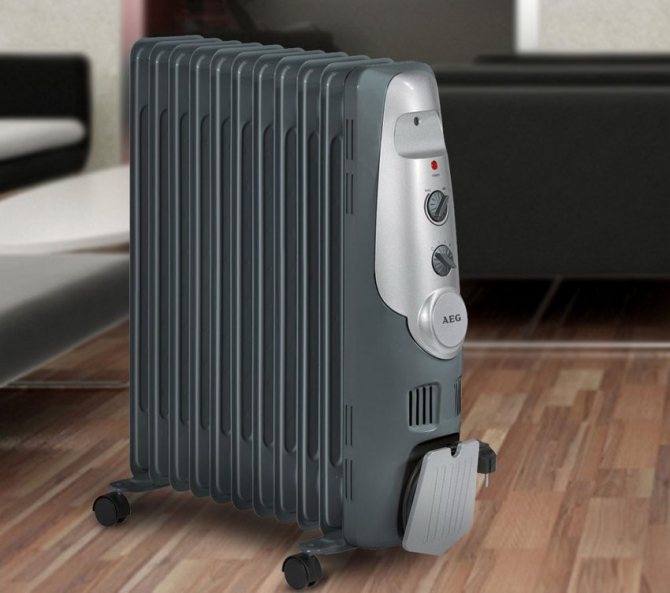

Oil radiators have many advantages, such as quietness, economy and safety.
As with any household appliance, the oil heater has its drawbacks. Among them are:
- The air in the room takes a long time to warm up, especially when it comes to a large room. This problem can be corrected by buying an oil heater with a fan: the heated air will spread faster.
- The structure itself weighs a lot, so it is better if the device is equipped with wheels. It is worth hanging an oil heater on the wall only if there are reliable fasteners.
Helpful advice! When choosing an oil heater, pay attention to the manufacturer. As a rule, brand awareness guarantees the high quality of the heating device.
Benefits
- Fire safety. Due to the low heating temperature of the housing (maximum 110 ° C), oil-fired domestic heaters are considered safer heating devices than other electric heaters. In addition, modern models are equipped with a horizontal installation sensor that turns off the heater if the device is installed at an angle. It also reduces the likelihood of fire.
- Quiet operation. Sometimes there is a slight crackling sound while the oil heats up. However, after the oil has warmed up to operating temperature, the sounds stop.
- Does not dry out the air or absorb oxygen. In many ways, this is why they are so often used for additional heating in bedrooms. This is their main advantage over fan heaters, which greatly dry the air.
- Mobility. The device is equipped with 4 wheels, so even a pregnant woman can easily move it around the room.
Types of oil heaters: wall and floor
Different models of heating devices may differ in power, size, appearance and other characteristics. For example, depending on the features of the location, such oil heaters are distinguished as:
- wall-mounted;
- floor;
- tabletop.
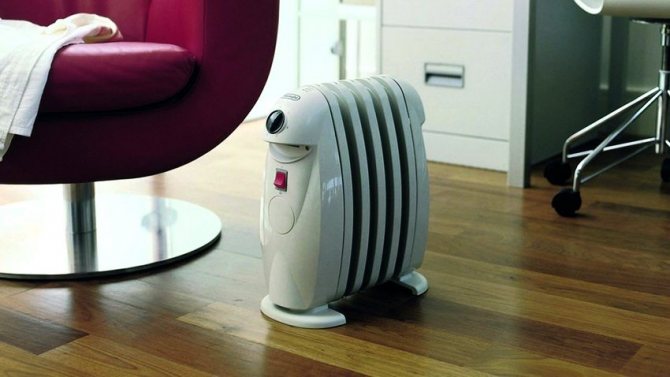

Oil heaters can be of different sizes and types of placement
Using a wall-mounted model saves space, but also increases the time it takes to warm up the air in the room. The fact is that the heated air rises upwards, so the lower the heating device is located, the more efficiently it works. Because of this, oil heaters are often installed under windows.
Floor-standing options are the most mobile. They can be easily moved from room to room, cleaned during unused time. The schemes of floor-mounted and wall-mounted oil heaters practically do not differ from each other.
In addition, such heating devices can have a large number of additional functions and capabilities. These include, for example, a fan that blows warm air around the room, a humidifier that allows you to create a comfortable level of humidity in the room. And the best oil heaters are equipped with temperature sensors and can be programmed to turn on and off at specific times.
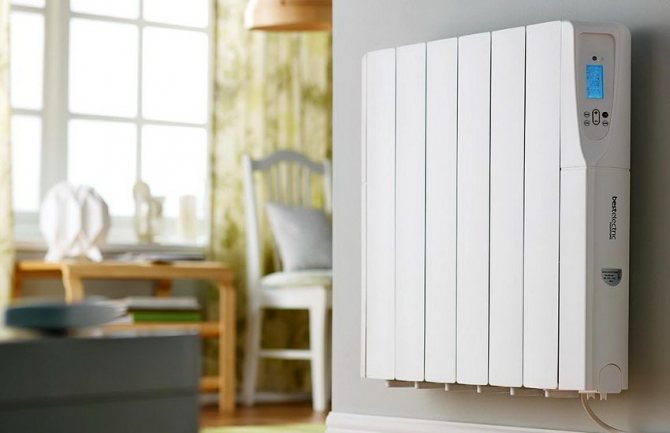

Quality oil heaters are equipped with temperature sensors, which helps to save energy
Additional elements of "advanced" models
Manufacturers of electric oil coolers equip some models with simple air humidifiers. Typically, this is a container into which the owners pour water. When heated, the liquid evaporates and compensates for the lack of moisture that appears due to overdrying of the air during the operation of the device.
In order to increase safety, the devices can be additionally equipped with special covers. They are used in children's rooms to prevent accidental burns of children. Such housings are believed to enhance convection. This is a misconception. The convection process is only getting worse due to the casing.
To facilitate the movement of a heavy appliance on the floor, rollers are attached to the heaters. They are supplied in a set, and the owner himself attaches the wheels to the case, if necessary. Depending on the model and manufacturer, radiators can be equipped with other additional elements: mounts for hanging on the wall, clothes dryer, protective mechanisms, etc.
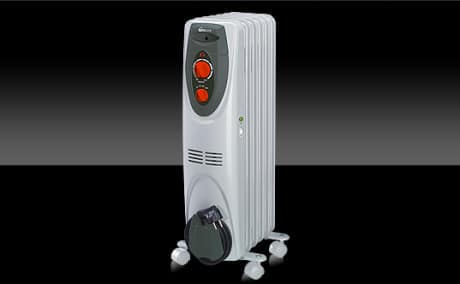

Timberk TOR is equipped with castors, built-in adjustable thermostat, overheating and frost protection. Convenient detail - cord rewind mechanism
Calculation of the power of an oil heater with and without a fan
The main criterion for choosing any heating device is its power. Therefore, before buying, it is worth measuring all the necessary parameters so as not to overpay, but also not to purchase an insufficiently powerful device. If your apartment has standard ceilings with a height of 2.75 m, then for heating every 10 m². you will need 1 kW of device power. With a different ceiling height, the heater power is calculated as follows:
- The length and width of the room is measured, its area is calculated.
- The resulting value is multiplied by the height of the ceilings, and its volume is obtained.
- The volume is divided by 25, since 1 kW of energy is needed per 25 m³.
The resulting figure will be the required power for your oil heater. The presence of a fan in the structure affects only the heating rate of the room, but not the required power.
Principle of operation
If you are planning to choose an oil heater, then first you need to study its principle of operation. The design is considered simple and includes: heating elements, radiators and mineral oil. The oil that will be contained in these radiators should only be 85% full. This is due to the fact that during operation, the liquid can expand significantly. If you do not know how to choose a water heater, then read the corresponding article.
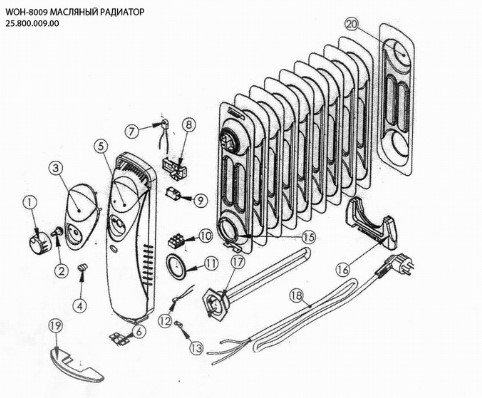

After connecting the device to the network, the liquid will begin to heat up quickly enough. As a result, heat will be transferred to the metal case. Also, you need to remember that the design of the device may have certain features. The main feature is considered to be a special valve, which is necessary in order to pour liquid into the system. If you are planning to opt for a new oil heater, then you will not find this addition. Another feature is that the device cannot be hung on the wall.
DIY oil heater
If you want to save money, you can make an oil-type heating device yourself. To assemble an oil heater with your own hands, you only need a metal case. Heating element and oil. The answer to the question of which oil to use in oil heaters is purified and heat-resistant.
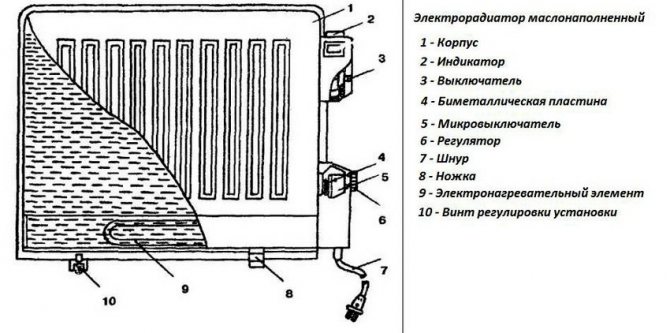

Diagram of the design of an oil-filled heater
This is necessary so that scale does not form on the walls of the heating element, and the oil itself does not boil at high temperatures. If you need to know more precisely which oil can and cannot be poured into oil heaters, then you should contact the professionals.
Helpful advice! An ordinary cast-iron battery can be used as a housing for a home-made heater. The material has good thermal conductivity, and inside such a case, you can easily install not only heating elements, but also a lot of other useful improvements.
The electrical circuit of an oil heater for self-assembly can be easily found on the Internet, and for greater efficiency, you need to choose the right heating element. It should be powerful enough, but without a magnesium anode, as it can quickly damage the heating element. Also, when assembling, it is necessary to understand the oil circulation pattern in the device.
To repair an oil heater with your own hands, you also need to understand the principle of operation of the device and the internal structure of the structure, as well as have special tools and skills, otherwise the repair may lead to more severe damage. If you are not confident in your abilities, then it is better to entrust this matter to experienced specialists.
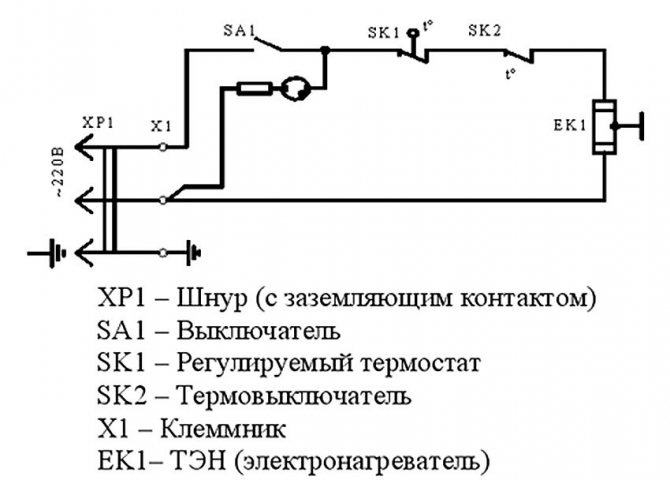

Oil cooler wiring diagram
Oil battery advantages and disadvantages
Most importantly, oil coolers lack a valve for draining mineral oil, because the oil does not evaporate, and there is no need to regularly top up or change it. Also, many devices are equipped with a rollover protection function, which ensures that the device is turned off when it is tilted horizontally.
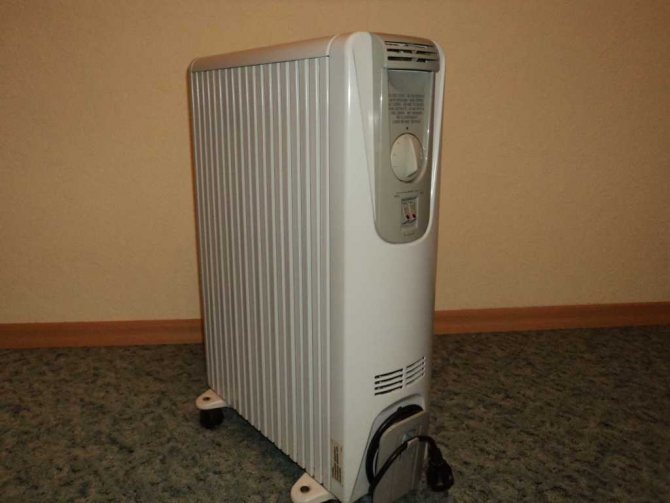

In addition, oil-filled electric heaters have a number of advantages.:
- Security, which is associated with the hidden location of the heating elements;
- Duration of operation;
- Compactness and ability to move;
- Low cost;
- Easy to install and assemble.
As already noted, many models have additional functions, such as a remote control or a humidification system, which make the device even more comfortable to use. At the same time, oil heaters have several disadvantages.
The heavy weight of the unit can cause inconvenience in situations where it is not possible to take advantage of the movement of the unit using the roller wheels.
Long warm-up (about 25-30 minutes). However, the problem of prolonged heating is absent in radiators with fans that circulate warm air, thereby heating the room faster.
The device and principle of operation of convector heaters
Convector heaters are not inferior to oil heaters in terms of design simplicity. It also has a heating element that raises the air temperature. The very name of the device comes from the principle of convection, when warm air rises up and cold air goes down. It is thanks to this air circulation that the room is heated.
To the question of how convectors differ from oil heaters, the answer is very simple - in the first type, the heating element directly heats the air, and not the body of the device. This offers a number of advantages, for example, the body of the device does not heat up that much. According to the type of energy consumed, electric, gas and water convectors are distinguished, each of which has its own characteristics, but structurally and in terms of power they do not differ too much from each other. The most common are electric convector heaters.
There are also infrared convectors that use infrared radiation to heat the air. As a rule, the efficiency of such models is low, therefore it is best to use combined convective-infrared heaters. They will be able to quickly and evenly heat the air even in a large room.
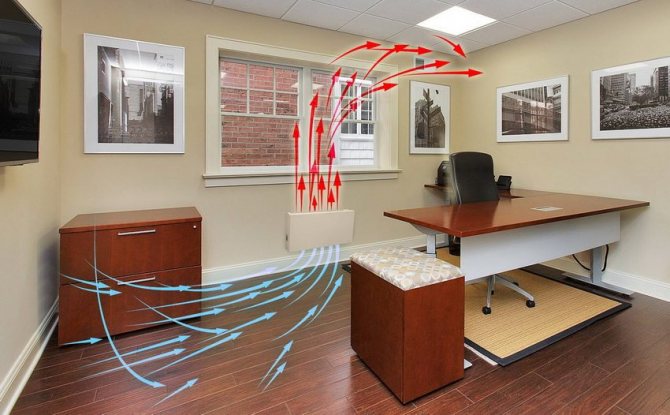

Convector heaters heat the room by circulating air
Types of oil coolers
Home appliance stores offer a large selection of heaters, from which you can choose:
- Floor structures are the most common appliances for space heating, which are equipped with wheels and are easy to move around the apartment. Floor-standing appliances most often consist of several ribs, due to which the heating efficiency is increased.
- Wall heaters - heating equipment in appearance resembles electric convectors or panel batteries. They are thinner than floor structures and have no ribbing.
- Heaters with a humidifier - the appliance is equipped with a water tank. When the radiators are heated, the water heats up and begins to evaporate, thereby humidifying the air in the room.
- An oil cooler with a fan is a design that combines a conventional air heater, a heat gun and a convector. A built-in low-noise fan sends warm air outside, which heats up the room much faster.
Pros and cons of convector heaters
Unlike a floor-mounted or wall-mounted electric oil heater, the convector does not heat the body, but immediately begins to warm up the air. This means that when using such a device, the room temperature rises much faster than when using an oil cooler. With the same power, an oil heater can warm up a large room for up to an hour, while a convector heater can handle it in a significantly shorter period of time.
Another advantage is that the body of a water, electric or gas convection heater practically does not heat up during operation, which eliminates the possibility of getting burned or damage to property. The use of such a heating device is completely safe, even if there are small children in the house. The body itself can be made of various materials with different levels of thermal conductivity.
Separately, it is worth noting the security systems of convector heaters. Almost every model has energy and temperature control, which can be carried out using an electronic or electromechanical thermostat. Also, many models have protection against high humidity, that is, they can be used not only in living rooms, but also in baths and other rooms with high levels of humidity.


Convector-type heaters are distinguished by the speed of heating the room, high safety and efficiency.
There are few disadvantages of this heater:
- Uneven heating of air at different heights - when using a convector, the difference in air temperature at the floor and at the ceiling can be up to 9-10 ° C, since the heated air immediately rushes upwards, and the cold air remains below.
- Dust circulates with the air, therefore it is not recommended to use the device in dusty rooms.
- It is possible to install convectors on the wall or near the ceiling, but this makes little sense, since in such cases the temperature difference at different heights will be even greater.
Helpful advice! The use of an infrared convection heater can somewhat reduce these disadvantages, but such models are characterized by a lower operating power.
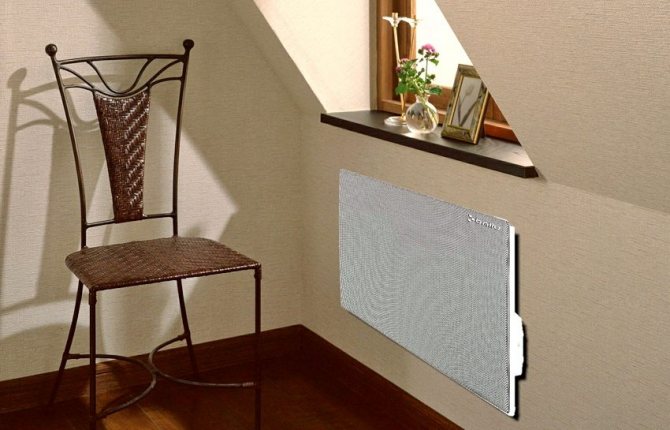

Wall mounted infrared heater of convector type
Criterias of choice
When choosing an oil-powered electric heater for your home, it is recommended to pay attention to its power, dimensions, number of sections and additional functions.
The power of the devices can be from 0.5 to 3 kW. For your home, you need to choose a unit at the rate of 1 kW per 10 square meters of room. In this case, the room should have one window, and the ceiling height should be from three meters. If there are more windows in the room, then 0.2 kW is added for each window.
It is very important to pay attention to the number of sections, which should depend on the area of the room. At the same time, units with a small number of sections heat up much faster. Stores offer heaters that can have anywhere from five to twelve sections.
Weight plays an important role in the quality and performance of the device. If the unit is bulky and at the same time lightweight, it is better to refuse the model. A large oil heater cannot be light. Low weight is achieved by lowering the oil level and using thin metal.
The built-in automatic thermostat will help to regulate the air temperature. If you set the required room temperature on it, the thermostat will maintain it in automatic mode. It is recommended to pay attention to the presence of this function, insofar as not all devices are equipped with automatic thermostats.
For cold rooms, it is recommended to choose heaters with fan heaters. The noise level during the operation of such a unit should be as low as possible, which must be checked upon purchase.
Almost all oil heaters are equipped with casters, which make them easy to move. When choosing a heavy device, you need to pay attention to the fact that the rollers are rubberized. When moving on the floor, they will not scratch the surface.
It is not uncommon to see units with a clothes dryer. This is a very convenient additional element that can be used in the off-season, when the batteries have already been turned off, and the heat outside has not yet come.
If the heater will be chosen for a children's room, then you should choose a model with a casing or buy it separately. Otherwise, the child may burn himself on the hot sections.
When choosing a model of an oil heater, it is necessary to take into account the fact that the more additional functions the device has, the more expensive it is.
Prices of oil-fired electric heaters and convectors
The price category of a heating device depends on its power, manufacturer, availability of additional functions and other characteristics. The price of a low-power oil household electric heater will be about 2,500 rubles. The cost of more powerful models is in the range of 3-4 thousand rubles. The heating area and the number of sections affect the price of the device.
When choosing a convector, you must also pay attention to the power and manufacturer. Here the price can vary from 1,500 to 4,500 rubles. Infrared models are cheaper, you can buy such a heater for 1000 rubles or less.
If you want to buy a Delongy oil heater, then be prepared for serious expenses, since the products of a famous brand are more expensive. If you do not want to overpay for a trademark, then you can turn your attention to heating devices from less well-known companies.
Comparative characteristics of three models of oil heater
Oil radiators of three brands - "De'Longhi", "Polaris" and "Caliber", of the same maximum power and number of sections were selected for the review.
De'Longhi KH 770715
Polaris 7 PRE S 0715 H
Caliber EMR-1511/7
| characteristics | De'Longhi KH 770715 | Polaris 7 PRE S 0715 H | Caliber EMR-1511/7 |
| power supply and power consumption | |||
| voltage, V | 220 | 220 | 220 |
| frequency Hz | 50 | 50 | 50 |
| maximum power, W | 1500 | 1500 | 1500 |
| operating modes, power consumption | |||
| number of operating modes | 3 | 3 | 3 |
| first mode, W | 700 | 600 | 600 |
| second mode, W | 800 | 900 | 900 |
| third mode, W | 1500 | 1500 | 1500 |
| control | |||
| room thermostat | mechanical | mechanical | mechanical |
| overheat protection | there is | there is | there is |
| control of heating modes | push-button | push-button | push-button |
| light indication when the mode is turned on | there is | there is | there is |
| General characteristics | |||
| type of shell | harmonic | harmonic | harmonic |
| the main colors of the radiator | black or white | black or white | black or white |
| number of sections | 7 | 7 | 7 |
| for space heating, m2 | 15-20 | 15-20 | 12-15 |
| size WxHxD, cm | 24x64x31 | 16x67.5x41 | 14x66x39 |
| Weight, kg | 11 | 10,2 | 7,2 |
| type of instalation | floor | floor | floor |
| wheels for moving | there is | there is | there is |
| brand owner | De'Longhi Appliances SRL, Italy | Texton Corporation LLC, USA | PPK Caliber-2001 LLC, Russia |
| country of origin | China | China | China |
| warranty, months | 12 | 12 | 12 |
| estimated service life, years | 5 | 5 | 3 |
| other options | |||
| heated towel rail | there is | there is | not |
| frost protection | there is | not | not |
| fan heater | not | not | not |
| humidifier | not | not | not |
| rollover sensor | not | not | not |
| programmable switching on | not | not | not |
| average cost, rub. | |||
| 2600 | 2100 | 1800 | |
Which heaters are better: oil or convector
To fully understand which is better, convector or oil heaters, you need to compare their main characteristics with each other:
- time of heating the air in the room. In the oil cooler, the heating element is first heated, then it heats the oil, which gives off heat to the body, which already begins to heat the air. In the convector, the air is heated immediately. It should be understood that if you are going to buy an electric oil heater with a fan, then it will warm up the air at the same speed as the convector, or even faster. This is due to the relatively low power of the convector heater;
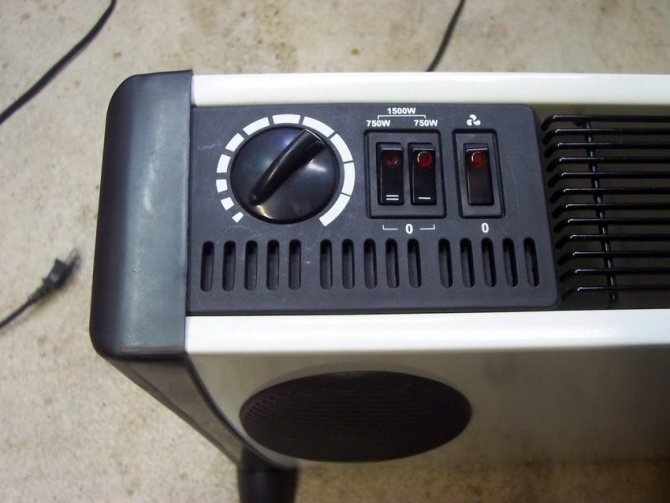

When choosing a device, pay attention to such an important characteristic as power
- electricity consumption. In this regard, the convector is about a quarter more economical than an oil cooler of the same power.This factor can be decisive, since the solid energy consumption of an oil device can cost a pretty penny;
- ease of installation and operation. Convectors weigh several times less than bulky oil appliances, therefore it is much more convenient to move them from place to place. In addition, they are easier to mount on the wall, although this reduces the efficiency of the work. Modern models of both types of devices are equipped with sensors, simple and understandable controls and displays, so that the level of ease of use is approximately the same and largely depends on the manufacturer and model;
- safety of use. The answer to the question of which oil heaters are better may well be those that heat up less during operation. Hot oil noticeably heats up the body, but convectors in this regard are completely safe. You can easily leave such a device turned on unattended, while it is highly discouraged to do this with oil;
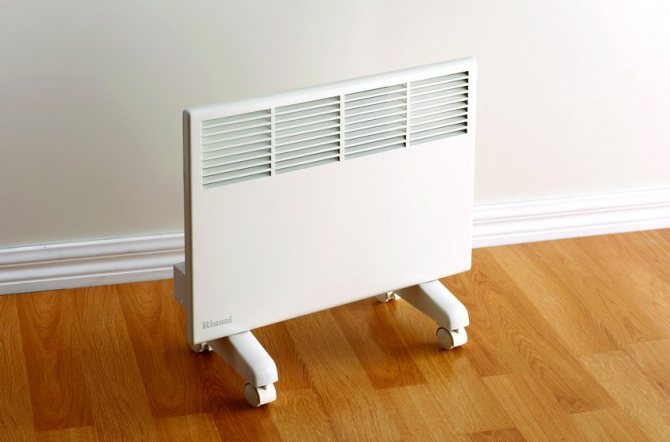

Compared to oil heaters, convector heaters are safer.
- environmental friendliness and safety for health. Oil or convector heaters do not have parts in their design that could burn oxygen, therefore, in this regard, both types are completely safe. During the operation of the convector, dust may circulate in the room, which does not happen with the operation of an oil heater. But here a lot also depends on the cleanliness of the room;
- durability. Convector heaters last much longer than oil heaters, and they are much easier to repair. One of the most common causes of a breakdown in an oil cooler can be the occurrence of microcracks, through which oil flows out and evaporates. Repair in such cases is very difficult or simply impossible;
- cost. Oil radiators are cheaper than convectors of the same power, but in terms of the aggregate performance characteristics they are significantly inferior to them, so the savings can be very doubtful.
In addition to the characteristics already listed, it is worth noting that the improvement of convector heating devices is much faster than oil ones, which are slowly but surely disappearing from the market. The newest invention in this regard is the monolithic heating element of the convector, which doubles the heat output of the device with the same electricity consumption.
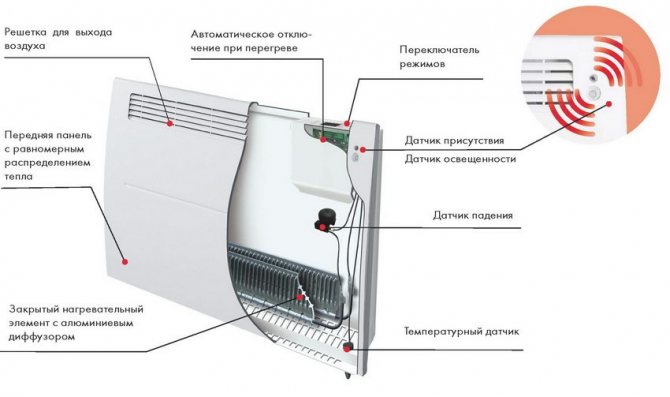

The device of a modern convector heater
In addition, when choosing a convector or an oil heater, it is necessary to take into account the degrees of protection, and according to this characteristic, the latter clearly loses. A rare convector is not equipped with protection against overheating, voltage surges and overturning. While often there are oil coolers without protection at all.
Safety measures: how to avoid oil heater explosion
Oil heaters break down like any other technique. The case sometimes leaks, the heating element stops working, the temperature controller may fail. These are all little things in life compared to the explosion of an oil heater. To avoid it, follow these simple rules:
- Buy equipment only in reliable retail outlets, choose well-known brands. World leaders are DeLonghi, Bimtek, General Climate trademarks. It is not at all necessary to buy them, but it is worth considering. Pay close attention to the reputation of the manufacturer.
- Follow the recommendations of the radiator manufacturer, use the technician within the period specified in the technical documentation. If the device has leaked, it is much safer to buy a new one than to use a repaired one, because the amount of coolant in it will decrease.
- At the beginning of the heating season, be sure to check the operation of the radiator. Make sure the thermostatic controls are working properly.
- Do not overturn the oil heater! Turn it off when leaving home.Never leave the heater switched on unattended.
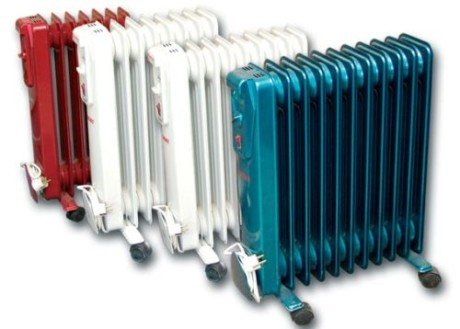

The choice of heating devices is extensive, you can always find a suitable model of good quality
If you initially chose a high-quality oil cooler from a trusted seller, you know the rules of safe operation, adhere to them, then the device will serve for many years. In the store, do not hesitate to ask questions and do not be lazy to read the technical specifications. If in doubt, discard the purchase and choose another model. Good luck!
Convector or oil heater: which is better to buy for home and office
Considering all the characteristics considered, we can say that convector-type heating devices have more advantages than oil ones. But this does not mean that the latter have completely surrendered their positions and are not used anywhere. Radiators with oil as a heat transfer medium are cheaper than other types of heaters, which still makes them very popular. Also, an oil cooler can be effectively used where rapid air heating is not needed, but its uniformity is appreciated. And models with a built-in fan can warm up the room even faster than a convector.
When choosing a model of a heating device for your apartment or office, consider the totality of its characteristics, the reputation of the manufacturer and other factors. A good oil cooler will be more efficient than a poor quality convector. Reviews also play an important role in the selection. Which is better, oil heaters or convectors of one type or another, you can find out from the reactions of users on the Internet.

